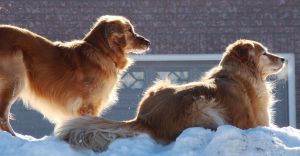Posted on Tue, Dec 8, 2009 : 11:50 a.m.
Top 8: Tips to keep your pets warm and safe this winter
By AnnArbor.com Staff
The colder temps have taken hold and winter is sweeping across the country. Starting tonight, Ann Arbor and other surrounding communities are under the first winter advisory of the season.
While you may be prepared for a winter storm - a full tank of gas and plenty of food in the pantry, etc. - don't forget to make plans to ensure your pet's comfort and well-being too.

- Don't leave pets outdoors when the temperature drops. Dogs and cats are safer indoors, except when taken out for supervised exercise.
- Pets who spend a lot of time outdoors need more food in the winter because keeping warm depletes energy. Use plastic food and water bowls outside rather than metal. When the temperature is low, your pet's tongue can stick and freeze to metal.
- Warm engines in parked cars attract cats and small wildlife, who may crawl up under the hood. To avoid injuring any hidden animals, bang on your car's hood to scare them away before starting your engine.
- The salt and other chemicals used to melt snow and ice can irritate the pads of your pet's feet and may be harmful if ingested. Wipe their feet with a damp towel before your pet licks them to remove snow packed between your pet's paws. Pet-friendly ice melts are available at many pet supply stores across the nation or online.
- Antifreeze is a deadly poison, but it has a sweet taste that can attract animals and children. Wipe up spills and store antifreeze out of reach. Better yet, use antifreeze-coolant made with propylene glycol, which is less toxic in small amounts than traditional ethylene glycol antifreeze.
- No matter what the temperature, wind chill can threaten a pet's life. A dog or cat is happiest and healthiest when kept indoors. If your dog spends significant time outdoors, however, it must be protected by a dry, draft-free doghouse that is large enough to allow the dog to sit and lie down comfortably, but small enough to hold in body heat.
- The floor should be raised a few inches off the ground and covered with cedar shavings or straw. The house should be turned to face away from the wind, and the doorway should be covered with waterproof burlap or heavy plastic.
- If you're feeding homeless cats, be sure to provide an insulated shelter for them. Information about building a shelter, spaying and neutering and more is available at humanesociety.org/feralcats.


Comments
bs
Wed, Dec 9, 2009 : 8:09 p.m.
Good advice, in most cases. There are, however, differences between dog breeds. My Siberian Husky loves being out in the snow, and will choose to stay out for long periods of time. The message..know your four footer, pay attention to health and welfare issues...